A Modular Content Process to Optimize for MUVERA

To rank in Google search with MUVERA, we need to produce Modular Content that satisfies its need for deep insights.
Google has rolled out many machine learning and AI systems to shift its results in the right direction. MUVERA is the latest one, and when it comes to matching intent, it's significantly more advanced than its predecessors.
We need to build content from semantic modules that MUVERA can process. And each section must satisfy search queries on its own.
What is MUVERA?
MUVERA is an advanced search algorithm from Google. It stands for Multi-Vector Retrieval via Fixed Dimensional Encodings, and it works by breaking content into its component parts.
It can efficiently measure the meaning behind individual sections and match those sections to search intent.
That makes it good at handling complex, conversational queries - exactly what Google needs to rank content quickly, at less expense, and with increased accuracy.
My assistant Gemini and I had a good look at a number of sites that did really well following the June 2025 Core update.
— Marie Haynes (@Marie_Haynes) July 18, 2025
In each case, it was really clear that Google did just what they said they would, surfacing helpful content from all types of sites.
I truly believe Google's…
Google says MUVERA understands meaning at a deeper level than RankEmbed and RankEmbed-BERT. It achieves 90% lower latency and 10% better recall for search tasks.

In practical terms: MUVERA can analyze passages so well (and so quickly) that it can promote a 1,200-word article from a subject matter expert over a low-effort 3,000-word article on the same topic.
Is MUVERA live now?
Something like MUVERA appears to be live now, based on the impact of the June 2025 core update.
I updated this section on August 4, 2025 thanks to a member of the Search Bar who shared this article:

In the SEJ article, José Manuel Morgal is quoted as saying:
...[Gary Illyes from Google] commented that they use something similar to MUVERA but they don’t name it like that.
So we're probably talking about a MUVERA-like algorithm.
Whatever was actually rolled out, there were pronounced ranking shifts among HCU-impacted sites. These suggest that information is being surfaced in a new way.
Glenn Gabe posted:
Google clearly adjusted something with their systems that evaluate the helpfulness of content.
I've heard my own clients report significant ranking changes, and there are many more examples. This post from Marie Haynes Consulting goes into a lot more detail:

MUVERA and LLMs use passage retrival
MUVERA and LLMs (using RAG) both reward content that can be understood and utilized at the passage level.
The process is different, but the approach is similar. They both break pages down into sections.
TOFU recently quoted me in its newsletter when it asked about new LLMO strategies. I talked about passage optimization for AI search.
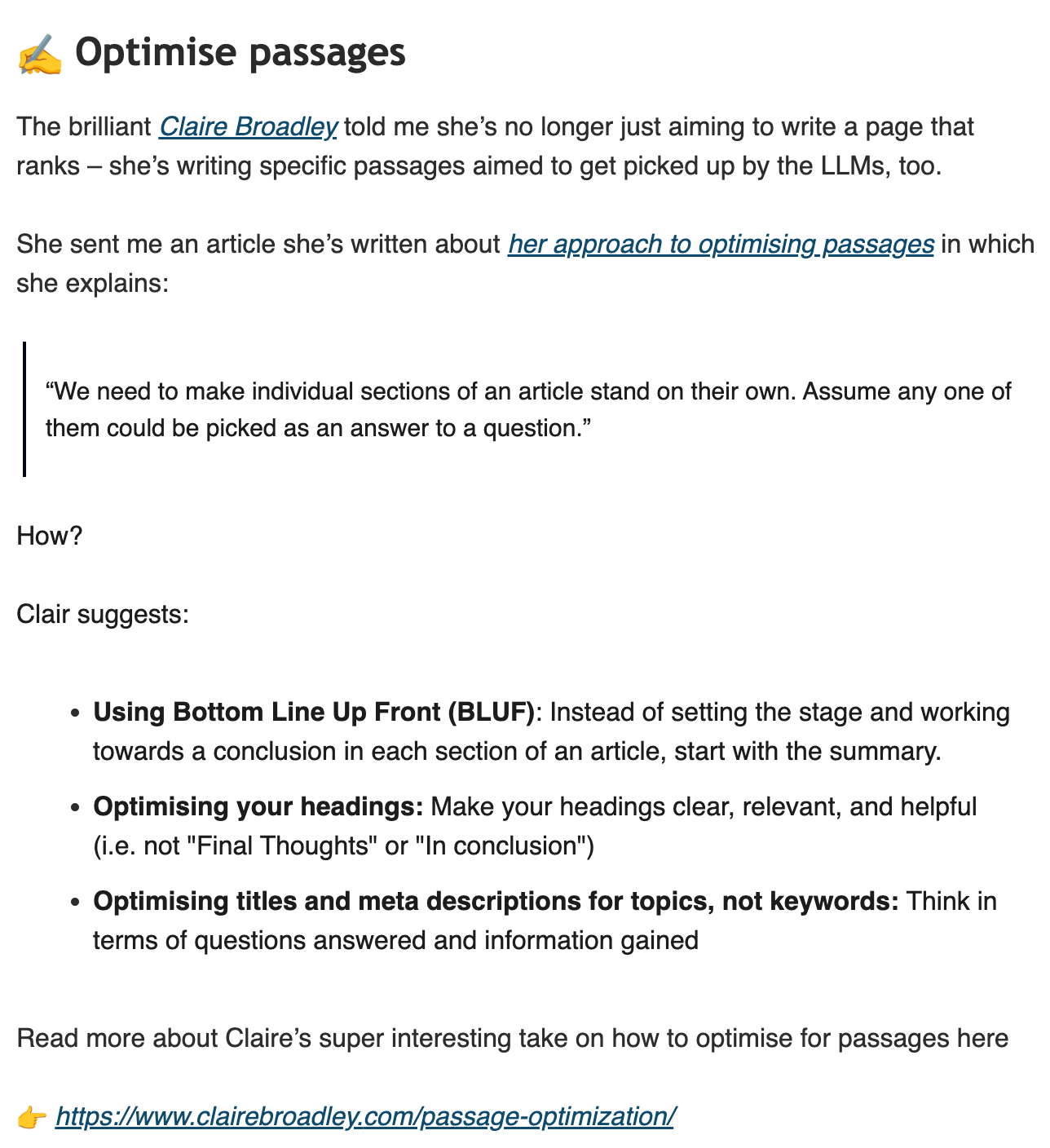
While this was about LLMs, passage optimization is important for Google search as well. It's a fail-safe option.
That's why I created this BLUF analyzer AI tool. Leading with your most important point aids passage retrieval, and it's one part of the Modular Content process.
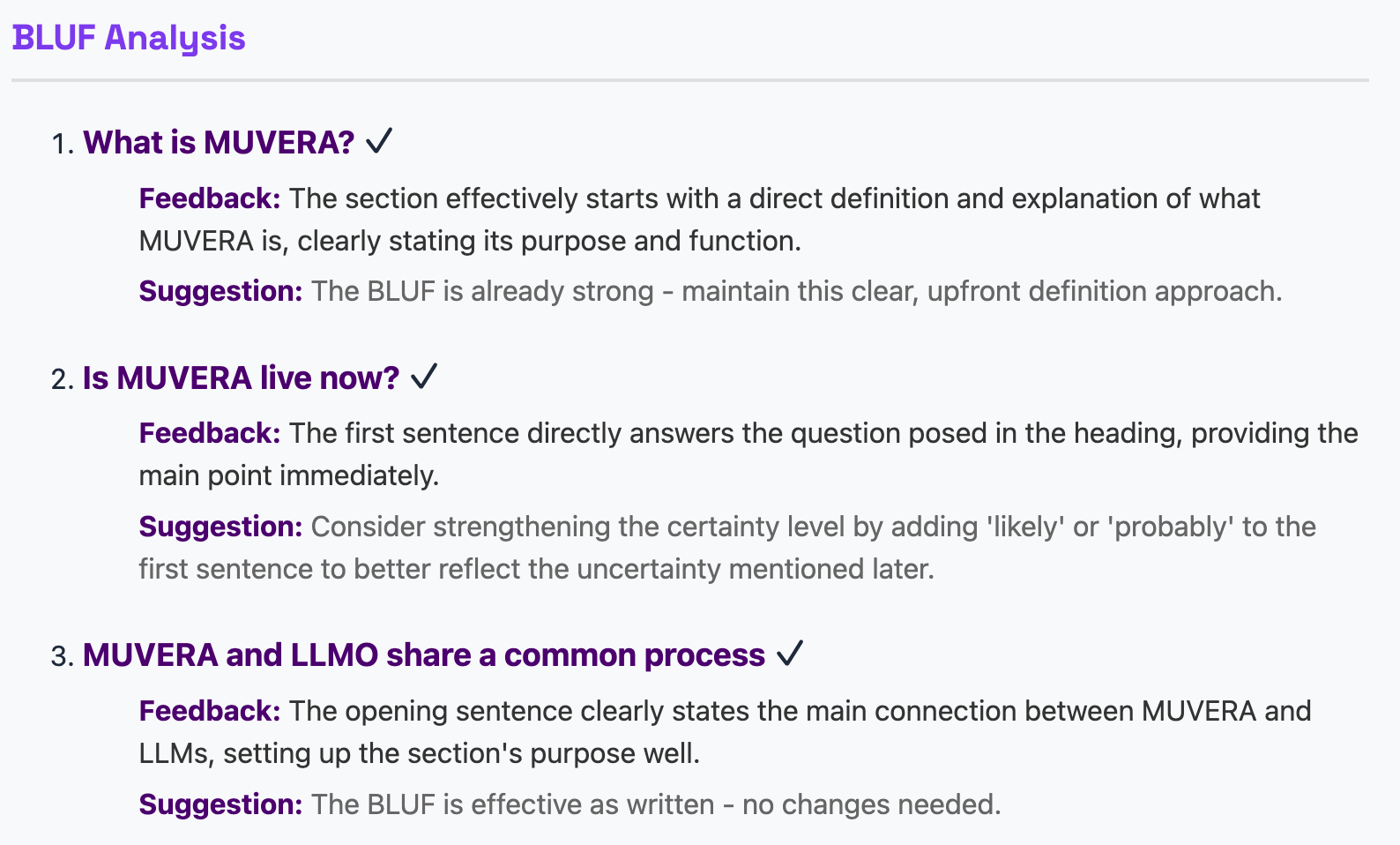
So if you're still thinking in terms of pages, change your approach. We need to think in terms of the component sections, or modules, that make up a page.
The Modular Content Process
The Modular Content process incorporates AI and humans. This is the blueprint.
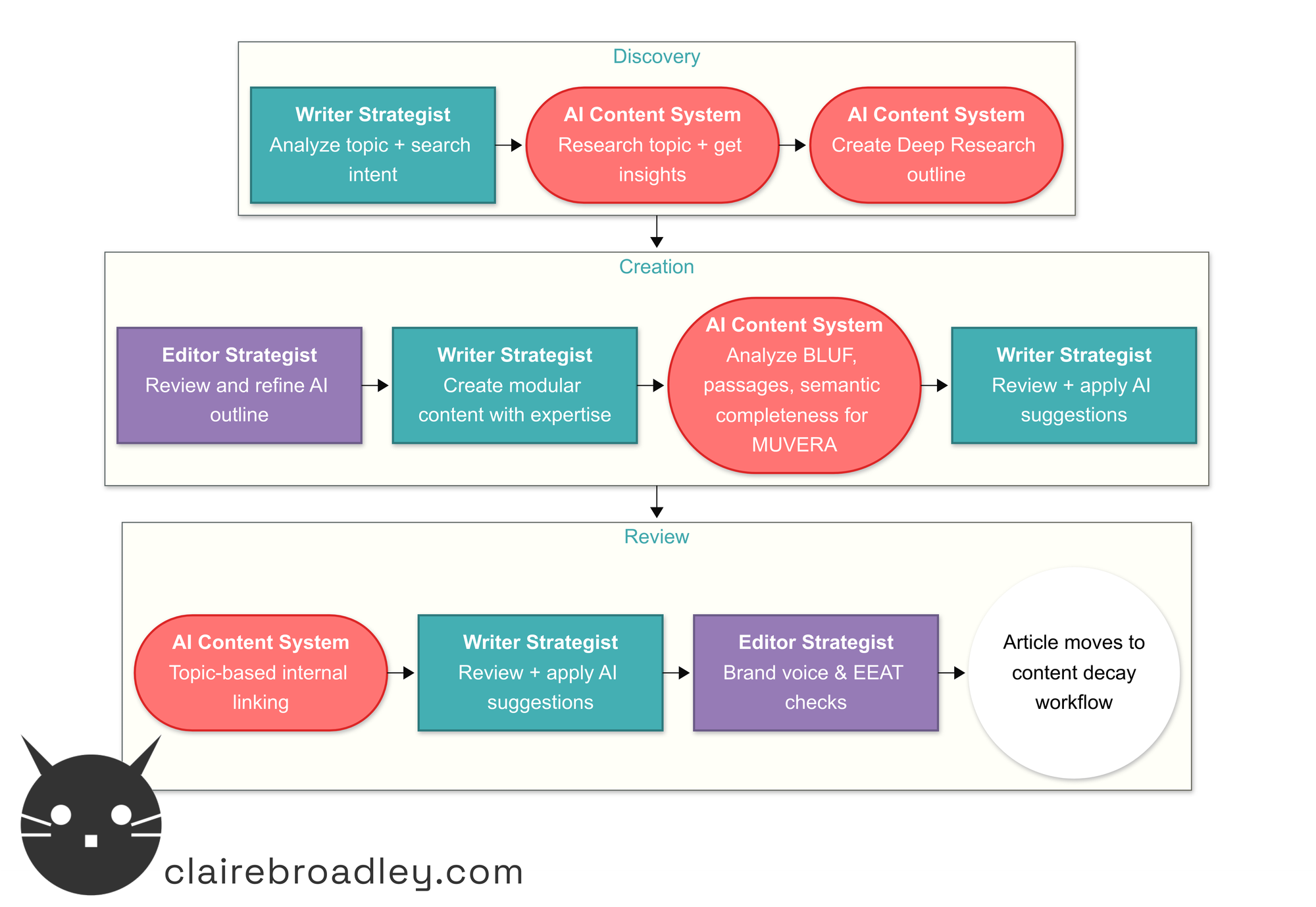
This is a high-level and flexible blueprint that can be applied in different size companies by tweaking the steps.
The important thing is that the content goes back and forth between AI tools and humans as its built. AI does the heavy lifting, then human experts validate.
For MUVERA (and LLMs), the AI Content System does some specific analysis in the middle:
- BLUF (Bottom Line Up Front)
- Passage analysis
- Semantic completeness
That's the important step that makes the content "MUVERA-optimized".
But humans need to be involved either side of it.
In terms of decision-making, Modular Content processes look like this:
- The Writer Strategist decides what is written, why it's included, and how the article is constructed; they should be free to create a unique structure each time
- AI Content Systems automate the parts of the process that are especially time-consuming for people; they also generate insights that are helpful in establishing authority
- The Editor Strategist steps in before and after the writing stage to perform high-level checks and ensure the content is aligned with business goals; this prevents topical drift and a temptation to chase the wrong metrics
It is not possible to automate high-effort content completely, but AI can help a great deal. The Modular approach keeps humans in the loop from beginning to end to ensure the content meets exceptionally high standards.
If you skip that human involvement, you risk leaning too far into optimizing for systems over people.
What are the results?
I've started applying a Modular approach with clients, focusing on question-based content and passage retrieval.
In the June core update, one client saw 500%+ increase in clicks for terms we're tracking. Separately, this client is also seeing a 157% increase from ChatGPT conversions.
We have two more project phases to go, but these early wins are a positive indication that the Modular approach is working for them.
Why modules help MUVERA
Modules help MUVERA because they allow the algorithm to evaluate and match individual content sections to specific search intents.
To understand this, we need some background. MUVERA works by converting meaning into math(s).
That's about as technical as I'll get, but check out Dave Davies' fantastic MUVERA tutorial if you'd like to learn more.

When it compares the content vectors to the search intent, it can drill down to find a match at the passage level.
And experts think that content is rewarded with better rankings when it demonstrates three qualities:
- Complete satisfaction: Is this the final step in the search journey? Does it comprehensively answer the searcher's questions so there's no need to click anything else?

- Authoritative depth: Does it eliminate the need for additional searches? Does it offer something entirely unique that only a true practitioner can provide?
- Strategic comprehensiveness: Does it cover related concepts that strengthen topical authority?
As Dave says:
The clever two-stage strategy (approximate then exact re-ranking) ensures that the final results are nearly as relevant as those from a full multi-vector approach. In search engines and recommendation systems, this means you get the best of both worlds: the precision of advanced deep models and the speed of classical search algorithms.
Speed and precision are imporant to Google as it moved AI Mode into the main search interface.
Don't mistake this as a measure of word count or content length. It's not as simple as comparing content on length. MUVERA is about whether needs are met. It's about whether latent questions and comparisons are anticipated and addressed.
We can write for MUVERA by thinking about two high-level optimization processes.
1. Passage optimization
Writing modular content means we have to stop thinking about pages as our baseline unit. The passage is the unit we want to focus on.
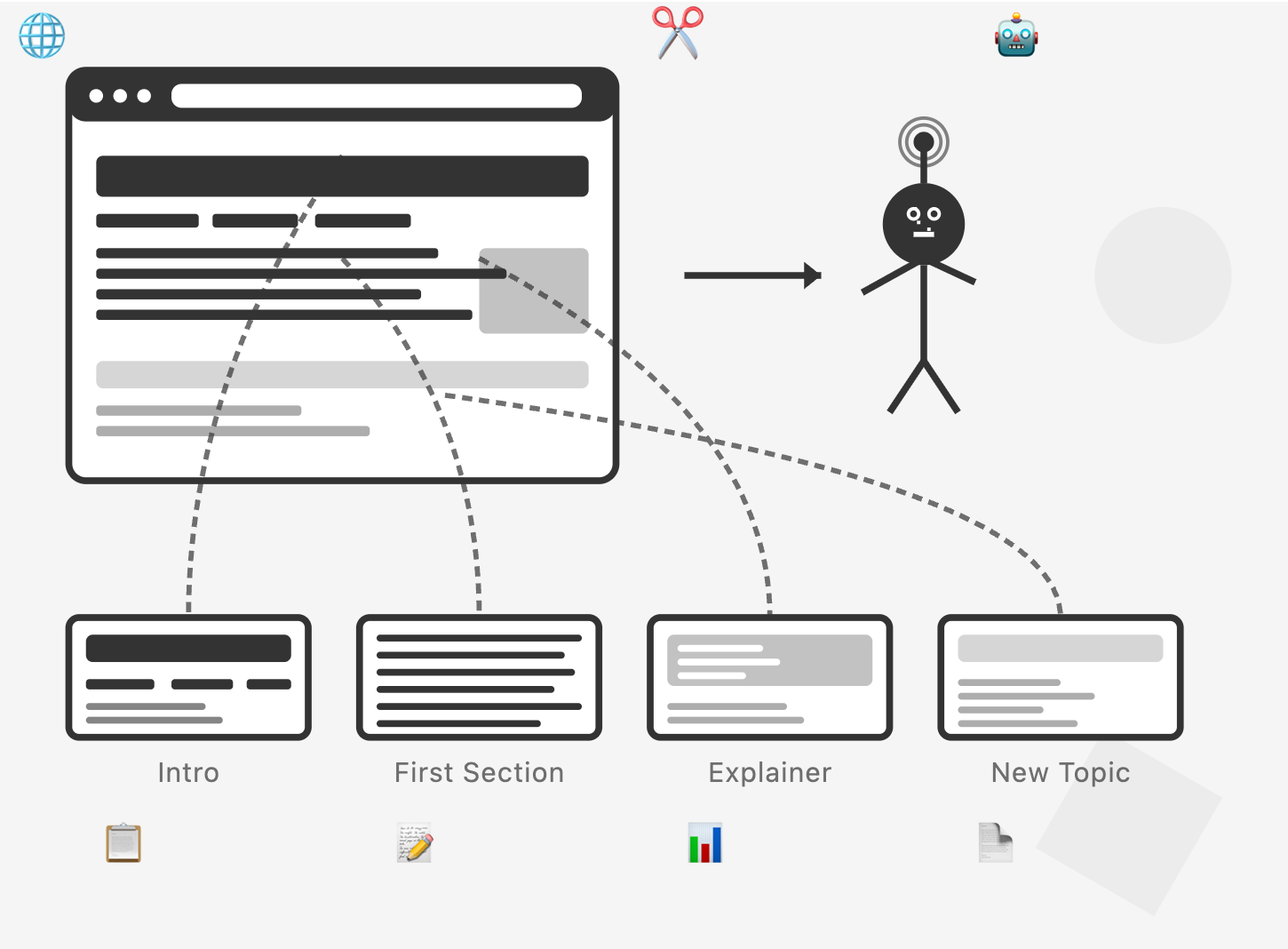
The only way to get a piece of content that is truly, completely optimized is to ask an excellent writer and practitioner to work on it.
Start with an AI outline, yes. But invest time and effort in the finished product.
Clear writing and clear structure helps humans a great deal, and great writers already do it as a natural part of their process.
2. Topical coverage
Topical coverage means building content in your area of expertise that fully addresses user needs.
Think of topics are the larger units that we build from passages:
- Individual articles, built from passages, comprehensively cover the topic
- Content clusters around the article to support and strengthen it
To do this, we need to docus on what your audience needs. Avoid the temptation to chase traffic for traffic's sake.
Remember the HubSpot "shrug emoji" post?
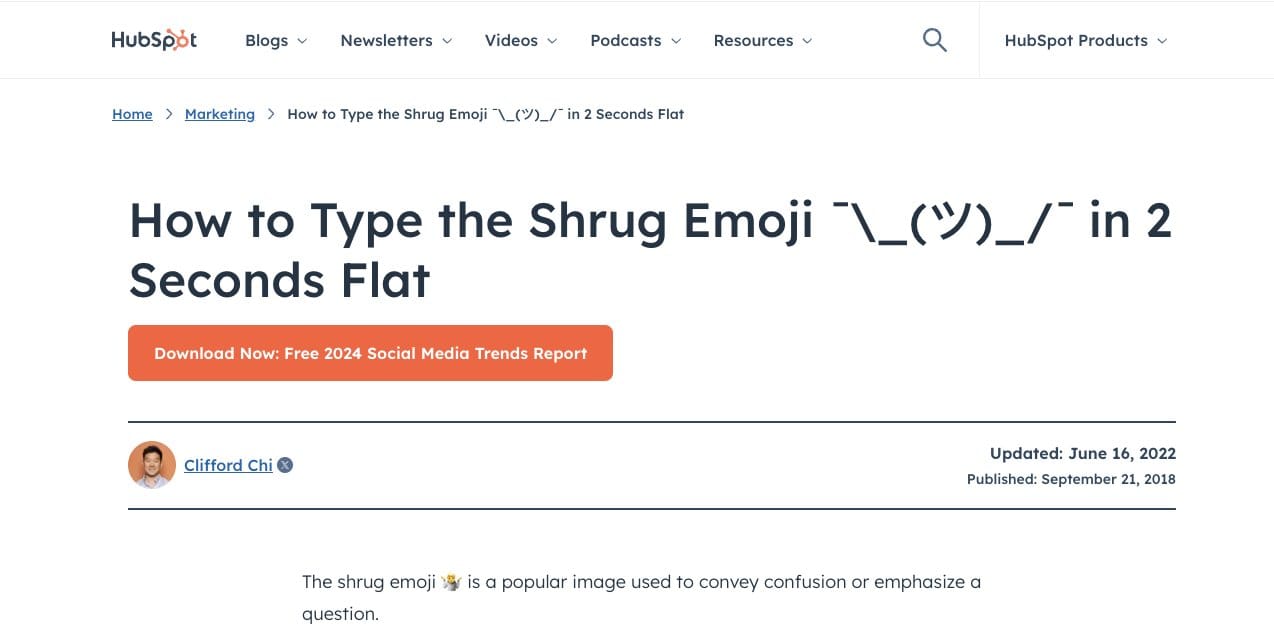
This was the focus of a lot of criticism when HubSpot's traffic started to slide. The core criticism was that it was off-topic.
I really feel for the HubSpot team, so I'm not here to say anything negative about their strategy. It clearly worked for a long time, and it was the model others copied.
I simply want to point out that we can learn valuable lessons about topical coverage from what happened to content like this.
- Chasing traffic can cause you to lose focus on what people want
- Genuinely, authentically think about what searchers need and deliver the best version of that
- Keep doing it, comprehensively and consistently
Again, this is not just "a Google thing". This is a future-proof investment in visibility. There's evidence that OpenAI has measures topical authority too.
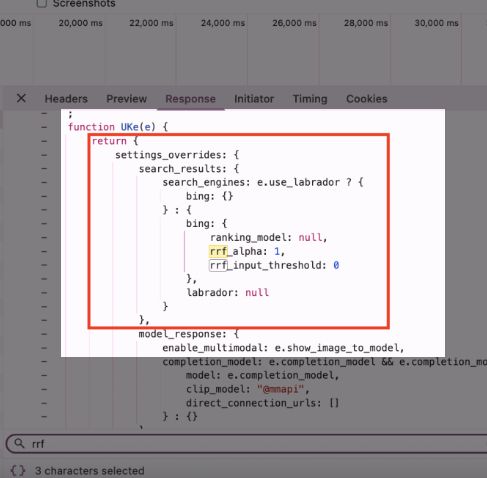
The business case for modular content
The Modular Content process delivers better ROI because one completed piece can rank for multiple search intents in multiple search engines.
My process also implements the 10-20-70 rule of successful AI implementation. Successful leaders put 10% of their resources into algorithms (which includes AI), 20% into technology and data, and 70% into people and processes.
Finally, MUVERA is capable of measuring the investment you're making, and that will compound. If MUVERA ranks your content in organic search, NavBoost will detect good engagement because human beings are actually reading it. It's Navboost's job to promote good rankings for content that people like.
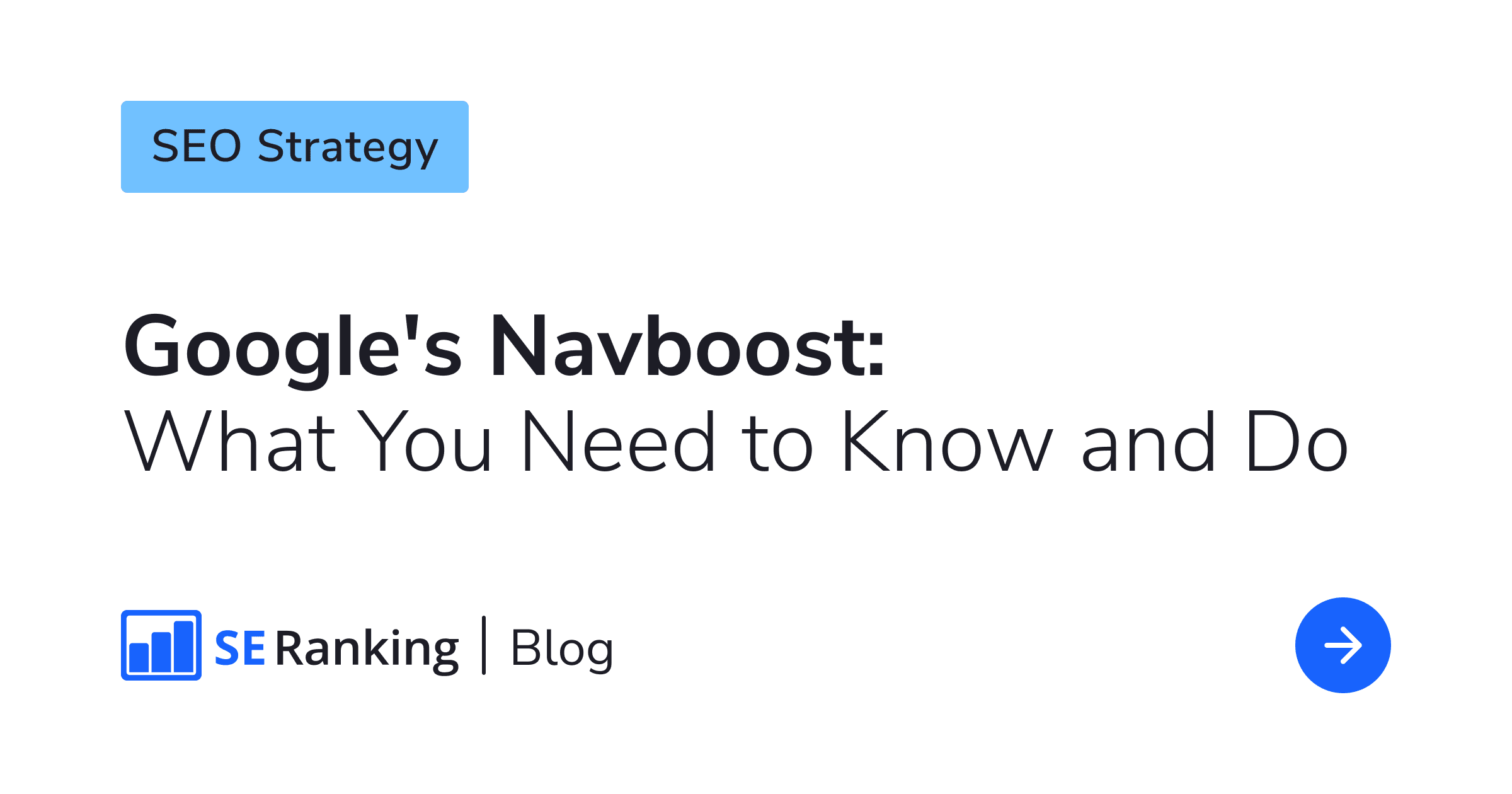
We're in the middle of a slow but unavoidable shift: from one dominant search engine to many. This is a time to place safe bets.
If your content strategy has a modular approach, you should be able to answer yes to these points:
- User satisfaction: Would each passage answer individual questions in a natural conversation?
- Completeness: Do all the passages on this page add up to a comprehensive answer?
- Shareworthy content: Are we offering unique insights that are mentioned on social media?
- Metrics: Are single articles ranking for multiple related queries? Are you seeing increased dwell time, session duration, and engagement rates?
If not, are you creating content for a version of Google that no longer exists?
Businesses already have the resources to write modular content that ranks. Use AI strategically to support that, and avoid distractions, like low-effort wins. Cutting corners might be more expensive in the long run.
The question isn't whether you can afford to invest in high-effort content now. It's whether you can afford not to.










Comments ()